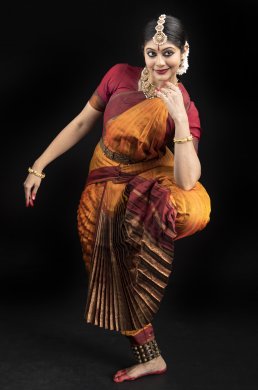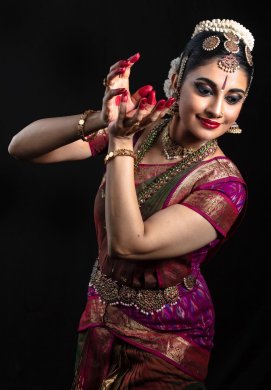
|   |

|   |
 e-mail: leelakaverivenkat@gmail.com Navarasa Sadhana - Breath control for emoting in art Photos courtesy: Natana Kairali April 16, 2021 Deep research into the technique of evoking the nine aesthetic sentiments or 'rasas' through the control of breath, by three generations of scholars in Kerala belonging to Kodungallur royal family, starting with Vidwan IlayaThampuran to Bhagavatar Kunjunni Thampuran, is what led to the discipline of Navarasa Sadhanam. The Kutiyattam master, late Ammannur Madhav Chakyar was one who constantly brought to bear on his extraordinary performances, this technique discovered by the Kodungallur family. Kutiyattam specialist G.Venu of Natana Kairali of Irinjalakuda, through years of deep inquiry into Kunjunni Thampuran's mind- boggling technique, became more and more convinced that this traditional knowledge system had to be made more accessible to enrich the contemporary performing artiste's technique. Egged on by Sasitharan Tirunalan of the intercultural Theatre Institute, and actor Kalyani Mulay from Maharashtra, in 2005 G.Venu, with some trepidation, embarking on a Navarasa Sadhana workshop for performers of various art disciplines, met with thundering response. And this attempt became a forerunner to yearly efforts, in which over a thousand actors over the years have participated. This year, the 50th Navarasa Sadhana workshop, held under the auspices of Natana Kairali, as every year, attracted dancers and actors from different areas, with Kapila Venu, the Kutiyattam performer moderating with very brief introductions. Tom Kingdon, Professor Emeritus, Emerson College Boston, well known theatre person who was with the Royal Shakespeare Company for twenty years, began his inaugural address for Navarasa Sadhana, lauding the immaculately trained bodies of Kerala's Kalaripayattu and Kutiyattam performers - able in a trice, of evoking all shades of emotion - this purely physical enterprise being without any personal emotional involvement on the part of the actor. This was in accordance with the Natya Sastra and its theory of rasa, through 'vibhava, anubhava and vyabhicharibhava'- evoked without the actor's personal inner investment in bhava. In fact, the actor had to keep his inner self uninvolved. The example was given of the Kutiyattam play when the actor playing Rambha having to repudiate Ravana's advances (the latter role played by Kunju Pillai) got so entranced by the expression in Ravana's come hither eyes, that she fell into his arms- and had to retire in disgrace! This pure bodily technique without involving the actor's bhava was in its outer-to-inner method of working very different from western theatre, where the actor's inner emotions were roused to create the outer expression. Gordon Craig in the 20th century had referred to performance devoid of personal emotion, though this had not taken roots. The western theatre used Stanislavsky's method acting of 'emotional memory' wherein an experience from the past creating a certain emotional response required in the enactment, was recollected by the actor, leading to felt emotions, expressed in the enactment. But the time lag of a past experience leading up to a present required mood, was found to create later emotional problems. Tom Kingdon was all praise for Venu's method of utilising traditional knowledge systems like Navarasa Sadhana, which otherwise would become a museum artefact - where breath control could add to the emotive power of acting - without interfering with the age old prescription of keeping personal emotion out of the expression of sentiment. G.Venu thought of strengthening bhava through improvisation based on imagination wherein breath control introduced a solid foundation of felt emotion. Among the participants, Shereen Saif was the one to provide some insight into how breath and acting go hand in hand -talking of inspiration and expiration and how breathing deep or shallow can make all the difference. She spoke of thin in breath expressing sringar and how in Bhayanaka, the breath 'sits in a different place'. Asking herself if emotion is physical or psychological or both, she said it is a physical state. Anything different from natural breathing is emotional. When the audience goes along with the actor, it develops a similar breathing pattern - which is the complete empathy one speaks of in 'sahridaya.' Professor George S.Paul, a great friend and well wisher of Natana Kairali, spoke of the body as a string puppet well controlled through this extraordinary technique of breathing. What an actor gained by knowledge of 'swarvayu' which became 'rasa vayu' through knowing something of Navarasa sadhanam, made him a better equipped performer. Sasitharan Tirunalan connected with the Cultural Theatre institute in Singapore, mentioned how he was struck by the skills of actors in Kutiyattam who needed nothing more than the physical body and a burning lamp to produce such great theatre. He praised G.Venu's method of turning intense subjectivity of emotion into a recoverable psycho physical state. Prachee Sathi, a Bharatanatyam student of Vaibhav Arekar, gave a fine explanation of how she had shifted her attention in abhinaya to sensorial exploration - with each sense organ including the skin feeling the emotion, which Kutiyattam and Navarasa Sadhana had taught her.  DakshinaVaidyanathan (Photo: Innee Singh) Many young dancers as participants mentioned how they had been helped by attending Navarasa Sadhana workshops over the years. Of the video performances screened for the occasion, DakshinaVaidyanathan Baghel's presentation comprised a Balamurali composition "Ennadainavettina.." set to raga Murali expressing a khanditha nayika refusing to entertain a nayaka, chiding him for his constant betrayals, with his inability to avoid being distracted by any pair of beckoning female eyes. Dakshina has a face which emotes well. But teacher Saroja Vaidyanathan's choreography of the composition needed thinning out, allowing the repose necessary for registering the dominant emotional motif. Instead of the action detailing various distracting encounters luring the nayaka, conveying these parts economically through subtle bhavabhinaya, with the sthayi bhava of the khandita nayika retained without constant distractions, would have made the statement emerge more powerfully.  Divya Ravi (Photo: Innee Singh) Divya Ravi, trained under Kiran Subramaniam, Bragha Bessell and now Mavin Khoo, presented Mavin's treatment of Kshetrayya's "Paiyyada" in raga Nadanamakriya set to Tisratriputa tala- wherein, veering away from the poet's intented treatment, the nayika bemoans a beloved who is no more. And Divya Ravi's abhinaya had deep conviction and a quality of silence.  Sanjukta Wagh But the performance stealing the thunder was Sanjukta Wagh's presentation of Gandhari. Based on Irawati's Gandhari, what the dancer brought into play using the Kathak technique, was an ocean of emotions playing in a woman whose feelings went much beyond rage or sympathy. A young princess with stars in her eyes singing "Aaja savariya, tose garuva lagaloon... raske bhare nain..." decorating herself, imagining the young handsome prince to whom she is soon to be wed, is jolted to find herself tied to a blind King. The sinned against princess, in the bitterness of self-inflicted darkness through life, seems blinded to the sins of her sons. What happened to the mother and woman in her when she experienced, without protesting, Draupadi being disrobed? Did she become less mother and more Gandhari? With just mellifluous guitar and a tabla with Deepa Adhikari's lighting, what Sanjukta achieved with open- ended Kathak movements as her medium, defies description. Just every line in her body screams power and energy holding the audience spellbound. And what powerful, emotive and sur filled singing her voice produces while dancing! If this is not power of the breath, I do not know what is. For me, a workshop on Navarasa Sadhana could have had no better finish.  Writing on the dance scene for the last forty years, Leela Venkataraman's incisive comments on performances of all dance forms, participation in dance discussions both in India and abroad, and as a regular contributor to Hindu Friday Review, journals like Sruti and Nartanam, makes her voice respected for its balanced critiquing. She is the author of several books like Indian Classical dance: Tradition in Transition, Classical Dance in India and Indian Classical dance: The Renaissance and Beyond. Post your comments Pl provide your name and email id along with your comment. All appropriate comments posted with name and email id in the blog will also be featured in the site. |